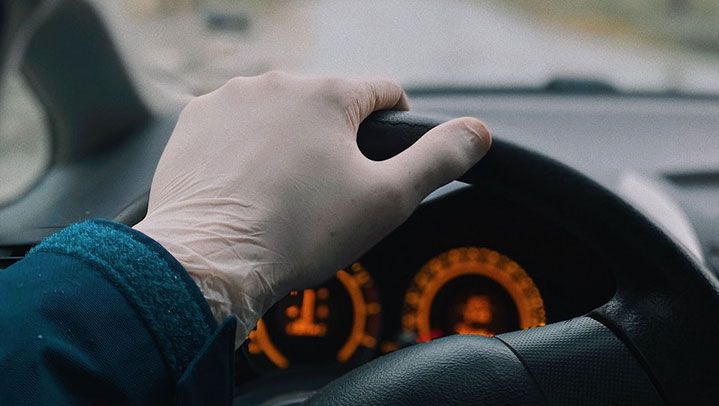The corona dashboard of the RIVM
This is how you build a dashboard that really benefits you
- Article
- Data Analytics

Our team follows the news about the corona dashboard of the Dutch National Institute for Public Health and the Environment (RIVM) with great interest. Creating such a dashboard is quite easy if the data is available. But how do you analyse and interpret it? Our Data Analysts will explain it to you.
As a data partner, we have deal a lot with dashboards. Together with the customer, we determine which figures are important, build links to unlock data from different systems, work on the visualisation, and use dashboards as input for our analysis tasks.
How do you create a dashboard?
Creating a dashboard is very easy. Creating a dashboard that will actually be used is a lot more difficult. We have seen a lot of dashboards, unfortunately also ones made by us, which, quite soon after deployment, were not viewed at all anymore. There are plenty of companies that, as an experiment, stopped updating/sending a dashboard for a while, only to find out that no one missed it.
You can read how to create a dashboard here. In this article, we use what we now know about the upcoming corona dashboard to analyse a real-life example.
Strategy, KPIs and the purpose of the dashboard
A useful dashboard contains information that is important for a strategy. The figures and visualisations are chosen for a reason. They are Key Performance Indicators (KPIs), or at least Performance Indicators (PIs), which, on their own or together with other figures, show what action you have to undertake. That means that before you start building a dashboard, you have to think about which data is important for your situation and what the purpose of the dashboard itself actually is.
The underlying strategy of the corona dashboard
This is the strategy behind the corona dashboard:
"The outbreak of the virus must be kept under control as much as possible. The most vulnerable people in society should be protected as much as possible. Healthcare in the Netherlands should not be overloaded. And at the same time, we want to keep society going as much as possible. For the economy, but also for the physical and mental health of all Dutch people. This means that the government wants to relax measures as much as possible, but only when it is really possible to do so. And if it turns out that we, as a country, are taking (or have taken) too much risk, any relaxed measures may have to be reversed."
The purpose of the dashboard is to show when further relaxation can be made, when all measures should remain as they are and when things may need to be reversed.

Why a corona dashboard is only now relevant
For a dashboard to be useful, the most important step is choosing KPIs and PIs that really matter. The precision and accuracy of those figures must be considered. And in a case like this (a dashboard that has to lead to actions), the delay in the figures must also be carefully considered in order to react quickly.
A good base
A dashboard is a visualisation of your data. If that data is not reliable, the insights you get from the dashboard are not either.
Some people who work with data a lot may feel that the corona dashboard was announced a bit late. Couldn't it have provided valuable insights much sooner? However, we must not forget that there are many challenges in linking and automatically obtaining the correct data. The corona dashboard is probably only now available because extensive time has been taken to set up the base properly.
Relevant figures
The figures relevant to assessing whether the virus remains under control have been thoroughly considered. It allows this dashboard to really lead to the right actions.
Timing
Apart from the timing, another factor is that the use of a dashboard is only now becoming really relevant. In the past it was relatively easier to determine the measures. The virus spread quickly and the pressure on healthcare was far too great. So we had to do as much as we could to reduce the spreading. The outbreak was so severe that economic and other interests were clearly subordinate to public health interests. The actions were, therefore, clear, and the figures in any dashboard would not have affected them.
Other interests
Now that the government has indicated that it currently has the outbreak of the virus under control, certain measures are being relaxed. Other interests come into play. However, it remains vital to know as well as possible whether the spread of the virus is under control. That way, action can be taken as soon as things take a turn for the worse again.
Regional differences
Regional differences also become relevant. If the virus starts spreading again in a specific region, perhaps it is not necessary for the whole country to immediately take a step back.

The well-known figures from corona communication
What will actually appear in the corona dashboard? The government has provided some examples, and we will discuss the well-known figures. We evaluate the data quality for each component. For the current dashboard, this comes down to answering the following 3 questions:
- How important is the figure for the strategy
- How much delay is there in the figure?
- How precise and/or accurate is the figure?
Number of deaths
The ultimate objective of the corona strategy is to prevent people from dying. That's why this is a very important figure. This does not mean that it is also the most relevant figure for the dashboard. Because preventing people from dying is done by keeping the spread of the virus to a minimum.
When someone dies, it often means that they were infected by the virus weeks before. So there is a huge delay in this figure. Rolling back relaxations based on this figure means that this action is actually implemented too late.
In addition, we could doubt the precision and accuracy of this figure. Only positively tested persons are counted by the RIVM, so it is not precise because not everyone gets tested. It is also inaccurate, as the number of tests increases daily, so simply looking at trends in this figure will not be a fair representation. If everyone with complaints are tested in June, the figure will become more accurate.
If you look at the excess mortality calculated by Statistics Netherlands, that figure is probably slightly more accurate and perhaps also more precise (depending on how stable the mortality trend has been in recent years). However, the delay is then even greater because this is calculated on a weekly basis.
Conclusion: this dashboard should lead to actions regarding the relaxation of measures or the reversal of previous relaxation measures. Even though this figure is the most important one for the corona strategy, it is not the most appropriate one for the dashboard. It will end up on the dashboard, but it will not be used to reverse relaxation measures. Should it be needed for this, then it is actually already too late, and chances are we will have to revert to an 'intelligent lockdown' again. However, it can be taken into account in a decision to implement further relaxations.
Number of hospital admissions
The number of hospital admissions is a figure that says a lot about the pressure on healthcare right now, so it's certainly important. Because almost all hospital admissions with suspected corona are also tested, we can assume that this figure is accurate and precise. Therefore, it is understandable that RIVM uses this figure a lot to inform the country about the spread.
The problem with the dashboard is that even someone who is hospitalised is likely to have been infected at least two weeks before. So this figure has also been delayed for too long to be able to reverse the relaxation measures on time.
Conclusion: the number of hospital admissions is accurate and precise and, in any event, has less delay than the number of deaths. This figure is thus appropriate for the dashboard, with a note that here, too, it is mainly of interest for the further relaxation of corona measures.
Number of positive tests
The number of positive tests is less delayed than the number of deaths and the number of hospital admissions. And it is not at all precise because only a part of the people with complaints are tested. It is also not accurate because the number of tests per day has often changed in the past period. This figure will become more precise and accurate when everyone experiencing symptoms is tested.
Conclusion: the number of positive tests is an important figure in the dashboard, especially if everyone with symptoms is tested.
Percentage of tests taken that are positive
The delay in the percentage of positive tests taken is the same as the number of positive tests. Precision also depends on how many people are being tested, but this figure is more accurate. It depends less strongly on the total number of tests (but partly, especially with low test rates).
Therefore, this figure shows slightly better trends in the spread of the virus than the total number of positive tests. If this percentage is low, we can also conclude that we see a higher proportion of actual infections reflected in the positive tests.
Conclusion: The percentage of positive tests taken is also important for the dashboard. This figure shows how reliable the number of positive tests is.
Number of corona patients in Intensive Care
The number of corona patients in the ICU is an important indicator of the pressure on healthcare. It is accurate and precise. The delay is relatively large, but it can at least indicate whether there is room for a possible increase at that time. It can therefore be used to decide whether a little more risk could be taken again without immediately overloading the healthcare. The delay must then be taken into account; if this figure starts to increase, it is also too late to use for reversing relaxation measures.
Conclusion: the number of corona patients in the ICU will definitely feature in the dashboard and will hopefully be used mainly as input for further relaxation measures and less for reversing it.
R0
The spread rate (R0) is the average number of people infected by one infected person. Perhaps this is the most important figure because it shows whether the virus is spreading further or whether it is slowly disappearing.
If R0 is above 1, the total number of infections will increase. If it is below 1, the total number of infections will decrease. It is based on positive tests and perhaps estimates based on other figures mentioned above. This does not make it the most precise or accurate figure. Here, too, we face delays.
Conclusion: as long as we have enough certainty that the figure is below 1, there is room for relaxation of the corona measures. When we suspect it is above 1, a reversal of the relaxation measures becomes necessary. Thus this figure is given a prominent place in the dashboard.
Indicators of crowding
The figures above are the ones we encounter most often in communication regarding the coronavirus. They are the most important figures, but also ones that all contain a certain delay in having insight into the spread of the virus.
So, in addition to these figures, the RIVM will look for indicators that provide faster information. Especially at times when the risks of spreading the virus seem to be increasing, the likelihood that relaxation measures will have to be reversed also increases.
A few things have already been covered in the news and we can also speculate a bit. Which figures could provide relevant information faster than the ones already mentioned? Because spreading mainly occurs when people are in close proximity to each other, we should specifically look for things that indicate crowding. These figures will generally be less precise and accurate but will also have much less delay and will, therefore, still be useful for this dashboard.
How to map crowds using data analysis
It is technically possible to link data from telecom companies (we will not go into privacy issues in this article) and thus see where many mobile phones were near each other. Places that are too crowded can introduce measures to avoid such crowding in the future.
We can also apply social listening to search for information about crowds on Twitter, for example. If cities or even specific streets or squares are mentioned in those messages, that could form the basis for specific security regions to take action.
Now that the catering industry has reopened, you can even search for messages about specific restaurants and/or cafes. This way, companies that take too much risk themselves can be closed again, instead of an entire sector that could possibly become the victim.
It is interesting for the government to apply social listening anyway. For example, there is more insight into public opinion about the corona measures. Read here what this looks like in practice.
Conclusion: a dashboard alone does not get us where we need to be. Keep evaluating!
In addition to the use of telecom data and the application of social listening, there are still countless examples to be found. What matters is that you properly evaluate why you choose a certain data source and a certain figure:
- Is it important for the underlying strategy?
- Is it exact?
- Is it accurate?
- How much delay is there in the figure?
But above all: how will a change in this figure (possibly in combination with other figures) lead to action?
It thus seems that the RIVM has chosen a good approach for this dashboard. The strategy is clear, the dashboard has a clear objective, the KPIs and other PIs have been determined, and the actions to be taken when the figures change are (hopefully) clear.
Perhaps targets have already been set to determine when exactly action must be taken. This dashboard has a solid foundation, and the time is right to start the actual visualisation.
This makes it a good example of how to approach such a process. This way you can build a dashboard that really works for you.
Have you been inspired, and do you want to map out the added value of dashboarding for your organisation? Please contact us.
This is an article by Anton Bies, Technical Web Analyst at Digital Power
Anton is a big proponent of data-driven marketing. Not deciding what to do purely based on experience, intuition or 'this is what everyone does', but using numbers as much as possible. Anton's professional motto is 'measure what you want to know'.
Technical Web Analystanton.bies@digital-power.com
Receive data insights, use cases and behind-the-scenes peeks once a month?
Sign up for our email list and stay 'up to data':